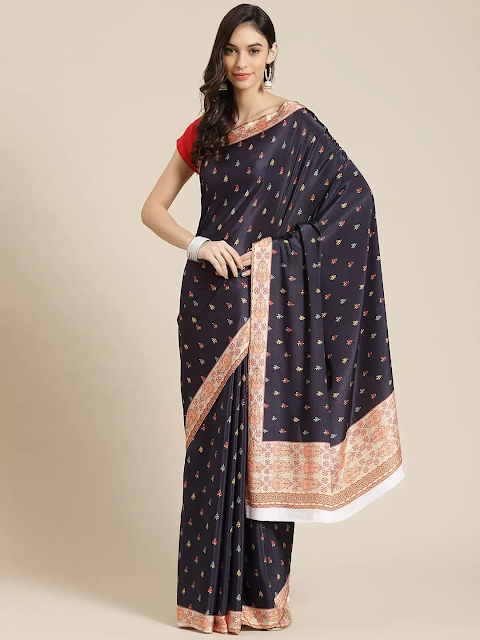Banarasi Sarees Have a Fascinating History
Banarasi Sarees Have a Fascinating History.
India's national garment, the saree, plays an essential role in women's lives. Most ladies wear the saree to any occasion because of its elegance and sophistication. The Banarasi saree is popular among women of diverse religions and origins, not just as a bridal attire in Bengal weddings. This Banarasi saree is making waves not only in India's fashion industry, but all around the world.
The delicate and exquisite designs woven throughout the six yards of ethnic clothing make this saree really lovely. Despite technological advancements, hand-weaving procedures are still used in Varanasi to weave stunning designs with gold and silver threads to make this Banarasi saree silk. These stunning and gorgeous sarees have become extremely popular and every woman's first choice when it comes to sarees. Zari, motifs, and emeralds have been used by designers to produce trendy and unique weavings that have grown popular among ladies all over the world.
Banarasi silk sarees have a long history.
The Hindu mythology of Ramayana, which took place between 1000 and 300 B.C., is where Indian sarees got their start. The Mughal Empire introduced Banarasi silk to India with its superior weaving and design craftsmanship. In today's Soft Banarasi silk saree, Mughal and Indian civilizations mix. Previously, this saree's silk was imported from China, but it is now sourced from India's southern states.
Indian sarees are divided into two categories: traditional wedding sarees and fashion sarees. Banarasi sarees are well-known bridal sarees that are available in a wide range of textures, colours, and patterns.
Banarasi Silk Sarees' Features
Banarasi sarees are made in Varanasi, Uttar Pradesh. They are one of India's best traditional sarees, and they are ideal for celebrations, festivals, and weddings due to their profuse embroidery. The four classic versions of this saree are organza (Kora), Georgette saree, Shatir saree, and pure silk (Katan). The different types of Banarasi silk sarees that have unique themes of animals, birds, floral, fruit, human figures, and geometric designs include organza, satin borders, jangla, Brocades, Tanchoi, cutwork, and Resham butidar.
Persian motifs are also utilised in Indian designs, resulting in beautiful flower patterns on sarees that are being worn today. Banarasi katan silk sarees were traditionally decorated with real gold and silver threads for the royal family. To make them more accessible to the general population, the threads have been replaced with coloured gold and silver threads. With eye-catching motifs and colours, this well-known saree is created on a handloom and exported all over the world.
Making of a Banarasi Saree
Weaving a Banarasi saree usually takes 15 to 30 days. It is, however, dependent on the design and pattern's complexity. This saree normally takes three weavers to weave. The first weaves the saree, the second runs the spinning ring that makes the bundles, and the third helps with border design. A group of people makes a Banarasi saree. A Banarasi saree must have approximately 5600 thread wires and be 45 inches wide to be considered authentic. The artisans make a base that is 24-26 inches in length. At the packaging stage, the themes are produced.
On graph paper, an artist drew designs and colour concepts to create design boards. After that, punch cards are prepared and hundreds of perforated cards are made to fit a single saree design before the final pattern is picked. The perforated cards are knitted on the loom with a variety of colours and threads. The perforated cards are then paddled in a systematic fashion to ensure the main weave picks up the correct colours and patterns.
Designs for Banarasi Sarees
Printed silk sarees are classified as Tissue, Butidar, Cutwork, Tanchoi, and Jangal. Golden zari brocade is woven into tissue sarees to give them a shiny sheen. Self-woven paisleys are used on the saree's borders and pallu. Butidar sarees are woven with silver, silk, and gold brocade threads. Because of the darker gold tone contrasted with the silver threads, the brocade patterning is known as Ganga-Jumuna.
Cutwork sarees are a less expensive option than Jamdani sarees. They're made using a cutwork technique on a basic texture. Leaves, jasmine, creepers, and marigold blossoms are common motifs on cutwork sarees. Tanchoi saree patterns are woven with colourful weft silk strands. The border of the saree is adorned with large paisley designs and criss-cross patterns.
Jangal sarees are made of vivid silk threads and are adorned with intricate Jangala designs and greenery that run the length of the saree. This Banarasi half saree, available at stylecaret online stores, is made of a luxurious fabric with intricate designs and craftsmanship, making it ideal for weddings and parties.
Fabric Varieties in Banarasi Sarees
The four main fabric types used in Banarasi sarees are Georgette, Shattir, Organza with zari and silk, and Katan.
Georgette is a delicately woven light fabric with crepe yarn woven into both the warp and weft. Salwar kameez, Bollywood sarees, and designer sarees are all popular costume types.
Shattir cloth is used to create beautiful contemporary and unique Banarasi saree designs.
On Organza, a luxuriously woven fabric, the warp and weft produce beautiful Brocade patterns and motifs. Zari brocade is manufactured by wrapping silk yarns with gold-coated silver threads.
Katan, a plain cloth with weaved pure silk strands, is used to make pure silk sarees. The beautiful themes and designs of katan sarees were previously woven on handlooms, but they are now woven on rapid looms and power looms.
Conclusion
India is only second to China in terms of silk production. India sells silk to about 200 nations worldwide, and demand is growing, particularly in Europe and America. The intricate patterns and intricate ornamentation on these ancient and beautiful Banarasi silk sarees have made them famous all over the world. Bollywood celebs and public figures are now wearing Banarasi sarees to weddings, special occasions, and functions. The Banarasi saree is a must-have for any woman's wardrobe.




Comments
Post a Comment